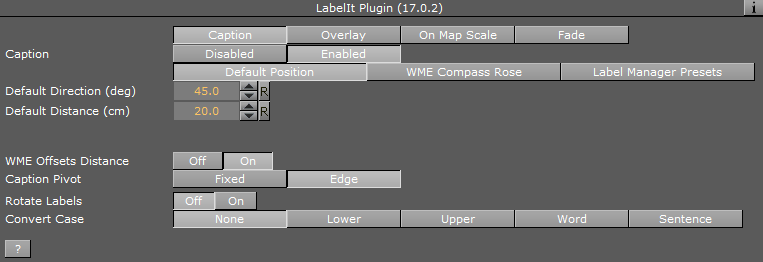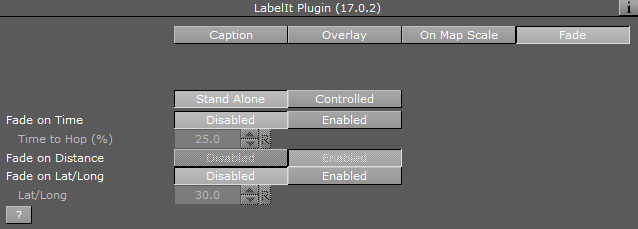
Viz World Plug-ins Guide
Version 17.0 | Published January 10, 2019 ©
Label It
![]()
The Label It plug-in manages 3D labels and place indicators. The plug-in creates a hierarchy under its container for adding a caption, body and pointer objects.
Note: This plug-in is located in: Built Ins -> Container plug-ins -> Maps
Label It Properties
Caption
Caption defines the relation between the label components (text and pointer). When disabled, duplicated labels use the label design exactly. When enabled, the labels use the following options:

-
Caption Pivot: Defines the connection point between the caption and the body when the caption is moved (rotated along the tip). There are two options, Fixed and Edge.
-
Fixed: Sets the connection point at the center of the caption.
-
Edge: Sets the connection point depending on the correct rotation. If the caption is above the tip, the connection point is at the middle lower side of the caption. If the caption is on the right side of the tip, it is on the left side of the caption. For example: A line moving from the tip to the center of the caption and where it crosses the caption bounding box is the connection point.
-
-
Rotate Labels: Defines whether labels, created in Viz (3D labels), are rotated like the labels in the Map Editor. When set to Off, all labels are displayed horizontally. When set to On, labels that were rotated in the Map Editor are also rotated in Viz.
-
Caption Source: The options Default Position, WME Directions, and Label Manager Presets include the properties described below.
Default Position
This is used when adding labels in WME when no direction is selected.
-
Direction (deg): Sets the angle of the label in relation to its geographic position.
-
Distance (cm): Sets the distance of the label from its geographical position.
-
WME Offsets Distance: Enables the WME to offset the distance when set to On (default). When set to Off, only the direction offsets from WME are used and the distance is ignored.
WME Directions
This allows you to set and fine tune offsets for every direction available in WME. When selected, the labels are placed as they were placed on the map in the Map Editor. When manually set inside WME they always take priority over the presets and Default Position settings. The default pointer direction (angle) and default distance between the pointer and the label is set by the map label parameters and used by the Map Editor (WME). If the direction and distance are changed while using the WME, the Default Direction and Default Distance values are ignored.
-
WME Compass Rose: Corresponds to the available directions inside the WME, as shown in the following image.

-
Direction Offset (Degrees): Determines direction offset for fine-tuning the position of the label.
-
Distance (Viz units): Determines the distance offset for fine-tuning the position of the label.
Label Manger Presets
When this is selected, the Label Manager plug-in uses the defined presets to place the labels over the map. The Label Manager plug-in optimizes the label position such that the labels do not overlap.
-
Number of Presets: Defines the number of label position presets available to the user (one to four presets). This parameter is only enabled when Caption Mode is set to Controlled.
-
Current Preset: Selects the preset number to be configured, using the Direction and Distance parameters. Each preset should be selected and the label position should be adjusted.
-
Direction (deg): Sets the angle of the label in relation to its geographic position.
-
Distance (cm): Sets the distance of the label from its geographical position.
-
Collision Mode: Defines how the labels are placed when an overlap or collision between two labels occur. With Tip, the pointers of overlapping labels can cross or touch, but no overlap of label bodies are allowed. With Bounding Box, a bounding box is calculated around the entire label (label body and pointer). An overlap between labels bounding boxes is not allowed.
Overlay
Navigator Overlay defines how the label is displayed over the map. Available options are Disabled, Fixed, Scaling, Near Scale and Far Scale.

-
Disabled: Places the label on the map using its geographical referencing.
-
Fixed: Places the label by keeping its geographical referencing, but using a different camera (either with dynamic image or with a front layer). The label size remains fixed.
-
Scaling: Places the label by keeping its geographical referencing, but using a different camera (either with dynamic image or with a front layer). The label scales to imitate the camera movement.
-
Near Scale: Defines the maximum size of the label on the screen (the final size of the label when zooming in).
-
Far Scale: Defines the minimum size of the label on the screen (the final size of the label when zooming out).
-
On Map Scale

-
Static Map Scale: Defines a scaling factor for the duplicated labels on a static map without camera movement when set to On. When set to Off, no scaling is used.
Fade
Stand Alone

-
Fade: Defines the fade effect parameters to be used with the duplicated labels. Available options are Stand Alone and Controlled. Stand Alone enables the user to define the fade parameters of the labels, while Controlled can be enabled to define the fade parameters when working with the Label Manager plug-in.
-
Fade on Time: Defines a label fade effect, beginning at a relative point to the defined hop duration. An additional parameter is enabled, Time to Hop, defining when the fade occurs.
-
Fade on Distance: Defines a label fade effect, beginning at a relative distance from the hop final location.
Note: The Fade On Distance parameter is enabled only if Overlay is set to Scaling.
-
Fade on Lat/Long: Defines a label fade effect, beginning at a Longitude and Latitude offset from the hop final location. An additional parameter is enabled, Lat/Long, defining the offset from in degrees.
Controlled

-
Step: Controls when the label fades in and out in relation to an animation. In general the fade can be based on the camera distance (for example; capitals are in view when distance is below 1000KM) or on timing in relation to the hop:
-
Auto: Fades in and out based on distance to hop when a label is of type point (added by the user). If the label is of type place/region, it fades in and out based on the distance set in the Label Manager plug-in. If the hop is not close enough for the label to show and the label was added by the user, it fades in based on hop timing and not distance.
-
On Hop: Links the fade to the hop timing.
-
Point 1/Point 2: Reserves labels where the distance is configured by the Label Manager plug-in.
-
Hop and Above: Turns on at the hop and stays on thereafter.
-
-
Selected Label Timings: Sets one of the timing options for the fade to occur:
-
At End: Fades the label after the animation stops and before it continues.
-
Close To End: Fades the label just before the animation stops and just after the animation continues.
-
Ahead: Fades the label before the animation stops and after the animation continues.
-
Well Ahead: Fades the label long before the animation stops and long after the animation continues.
-
-
Label Priority: Sets the duplicated labels priority. This parameter is useful for a large number of onscreen labels and not all can be displayed. The priority levels define which labels are displayed and which labels are hidden.
-
Auto: Allows the Label Manager plug-in to set priorities.
-
Normal, High: Sets priorities to normal and high.
-
Always: Displays labels every time.
-
Practical Use
When adding a Label It plug-in, three containers are added under the Label It container: CAPTION, BODY and TIP. Drag a text object under the CAPTION container. The BODY container is the pointer’s body and the TIP is the pointer’s end.
IMPORTANT! A text object under the label design must be named label to receive the name of the object from the CWMClient plug-in.